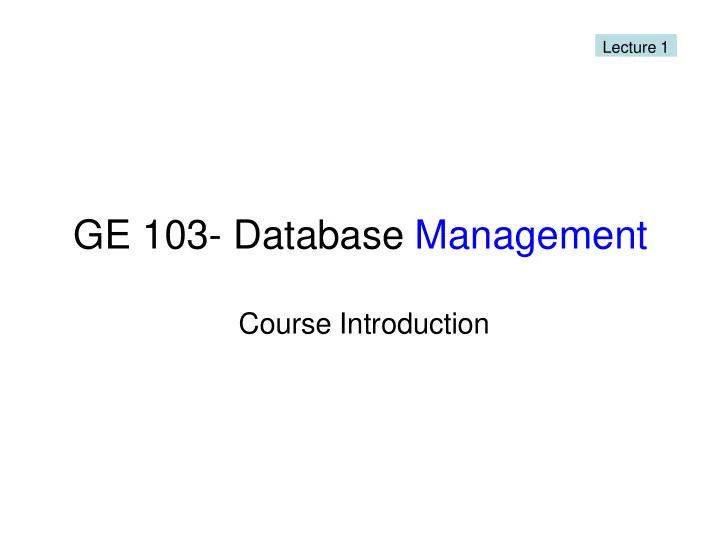

Lecture 1 GE 103- Database Management Course Introduction
DBMS Database == Data collection managed by a specialized software called a Database Management System (DBMS)
Why a whole course in Databases? Banking, ticket reservations, customer records, sales records, product records, inventories, employee records, address D boo a ks, t d a em b ogr a s ic e rec s ords a , st r e aph ud ent records, course plans, schedules, everywhere! surveys, test suites, research data, genome bank, medicinal records, time tables, news archives, sports results, e- commerce, user authentication systems, web forums, www.imdb.com, the world wide web, …
Examples • Banking – Drove the development of DBMS • Industry – Inventories, personnel records, sales … – Production Control – Test data • Research – Sensor data (25GB/h for a car) – Geographical data – Laboratory information management systems – Biological data (e.g. genome data)
Why not a file system? File systems are • Structured • Persistant • Changable • Digital … but oh so inefficient!
Modern DBMS • Handle persistent data • Give efficient access to huge amounts of data • Give a convenient interface to users • Guarantee integrity constraints • Handle transactions and concurrency
Database Management Systems • Hierarchical databases: – ”Easy” to design if only one hierarchy – Efficient access – Low-level view of stored data – Hard to write queries • Network databases: – ”Easy” to design – Efficient access – Low-level view of stored data – Very hard to write queries
Course Objectives Design Construction Applications Usage
Course Objectives – Design When the course is through, you should – Given a domain, know how to design a database that correctly models the domain and its constraints ”We want a database that we can use for scheduling courses and lectures. This is how it’s supposed to work: …”
Course Objectives – Design • Entity-relationship (E-R) diagrams • Functional Dependencies • Normal Forms code day hour roomNr name name Course Of Lecture In Room dept building responsible
Course Objectives – Construction When the course is through, you should – Given a database schema with related constraints, implement the database in a relational DBMS Courses(code, name, dept, examiner) Rooms(roomNr, name, building) Lectures(roomNr, day, hour, course) roomNr -> Rooms.roomNr course -> Courses.code
Course Objectives – Construction • SQL Data Definition Language (DDL) CREATE TABLE Lectures ( lectureId INT PRIMARY KEY, roomId REFERENCES Rooms(roomId), day INT check (day BETWEEN 1 AND 7), hour INT check (hour BETWEEN 0 AND 23), course REFERENCES Courses(code), UNIQUE (roomId, day, hour) );
Course Objectives – Usage When the course is through, you should – Know how to query a database for relevant data using SQL – Know how to change the contents of a database using SQL ”Add a course ’Databases’ with course code ’TDA357’, given by …” ”Give me all info about the course ’TDA357’”
Course Objectives – Usage • SQL Data Manipulation Language (DML) INSERT INTO Courses VALUES (’TDA357’, ’Databases’,’CS’, Mickey’); • Querying with SQL SELECT * FROM Courses WHERE code = ’TDA357’;
Course Objectives - Summary You will learn how to • design a database • construct a database from a schema • use a database through queries and updates • use a database from an external application
Course Book "Database Systems: The Complete Book, 2E", by Hector Garcia-Molina, Jeffrey D. Ullman, and Jennifer Widom
Alternative versions "First Course in Database Systems, A, 3/E" by Jeffrey D. Ullman and Jennifer Widom "Database Systems: The Complete Book", by Hector Garcia-Molina, Jeffrey D. Ullman, and Jennifer Widom
Web Resources -Website (Course Homepage) http://aytugonan.cbu.edu.tr/GE103_index.html - Slides of lectures - Exercise sessions + solutions - Lab assignment - Extra information - Sample exam questions and solutions
Teaching staff - Lecturer/Course responsible: - Assoc . Prof. Dr. Aytuğ ONAN (aytug.onan@ikcu.edu.tr) (aytugonan@gmail.com) - Course assistants: - Research Assistant Fatma Günseli ÇIKLAÇANDIR
Evaluation Criteria - Quizzes (2) 15% - Term Project (1) 15% - Midterm Exam (1) 30% - Final Exam (1) 40%
Recommend
More recommend